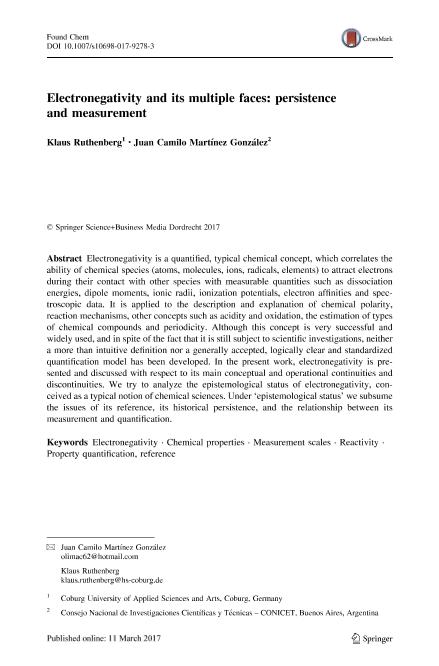Artículo
Electronegativity and its multiple faces: persistence and measurement
Fecha de publicación:
04/2017
Editorial:
Springer
Revista:
Foundations of Chemistry
ISSN:
1386-4238
e-ISSN:
1572-8463
Idioma:
Inglés
Tipo de recurso:
Artículo publicado
Clasificación temática:
Resumen
Electronegativity is a quantified, typical chemical concept, which correlates the ability of chemical species (atoms, molecules, ions, radicals, elements) to attract electrons during their contact with other species with measurable quantities such as dissociation energies, dipole moments, ionic radii, ionization potentials, electron affinities and spectroscopic data. It is applied to the description and explanation of chemical polarity, reaction mechanisms, other concepts such as acidity and oxidation, the estimation of types of chemical compounds and periodicity. Although this concept is very successful and widely used, and in spite of the fact that it is still subject to scientific investigations, neither a more than intuitive definition nor a generally accepted, logically clear and standardized quantification model has been developed. In the present work, electronegativity is presented and discussed with respect to its main conceptual and operational continuities and discontinuities. We try to analyze the epistemological status of electronegativity, conceived as a typical notion of chemical sciences. Under ‘epistemological status’ we subsume the issues of its reference, its historical persistence, and the relationship between its measurement and quantification.
Palabras clave:
Electronegativity
,
Chemical Properties
,
Measurement Scales
,
Reactivity
Archivos asociados
Licencia
Identificadores
Colecciones
Articulos(SEDE CENTRAL)
Articulos de SEDE CENTRAL
Articulos de SEDE CENTRAL
Citación
Ruthenberg, Klaus; Martínez González, Juan Camilo; Electronegativity and its multiple faces: persistence and measurement; Springer; Foundations of Chemistry; 19; 1; 4-2017; 61-75
Compartir
Altmétricas




